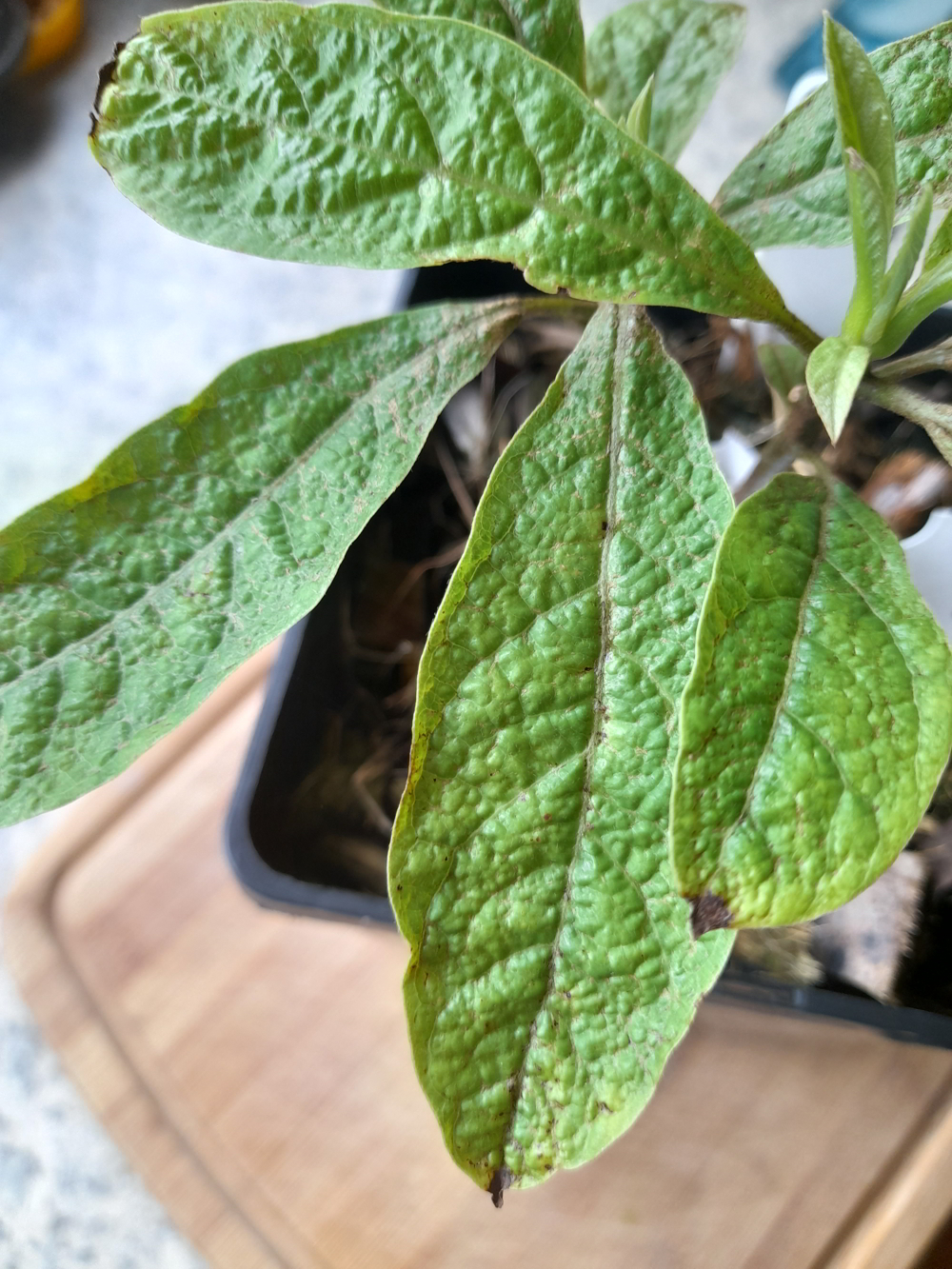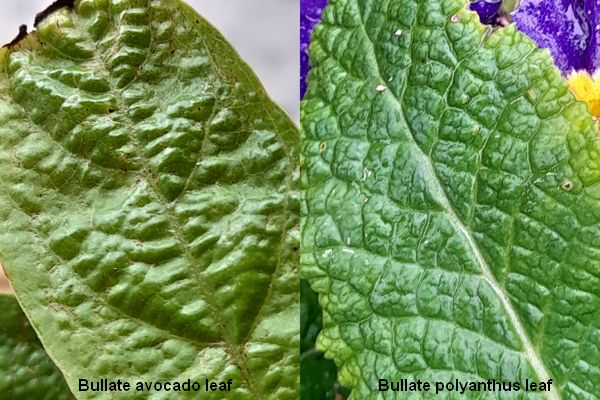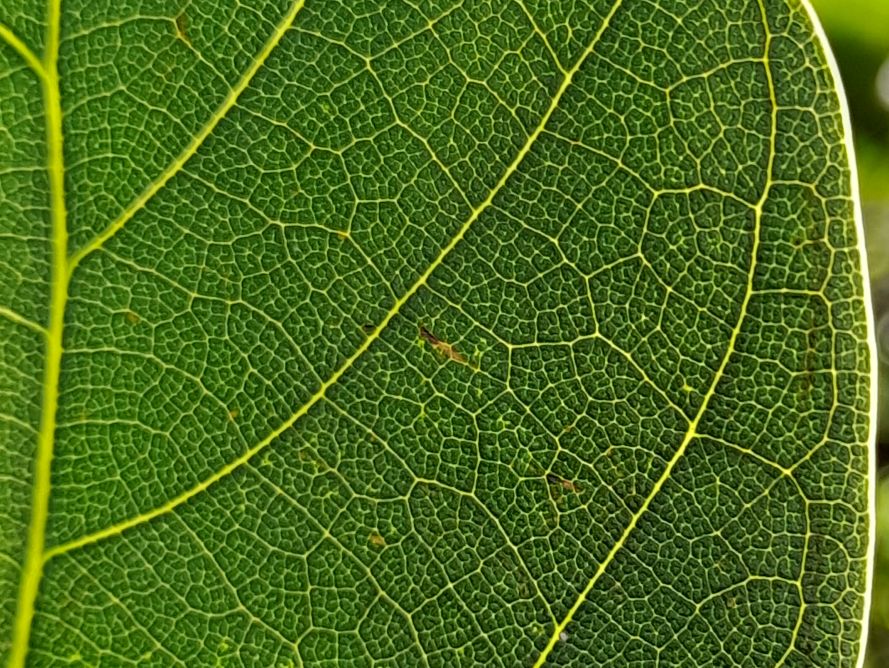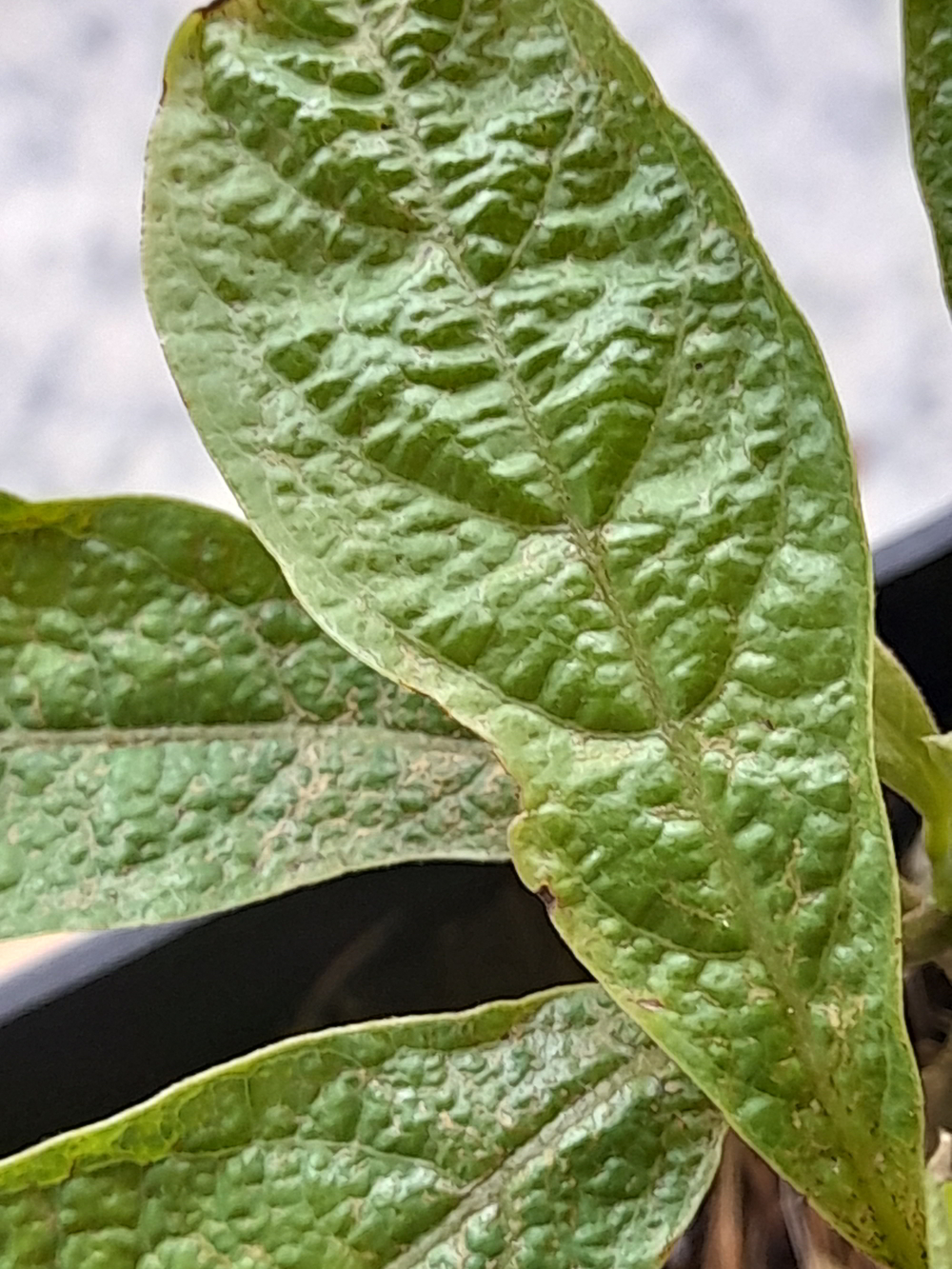A Possible Bullate Leaf Mutation in Avocado
by Laurie Meadows
First published 12 July 2022
An unusual seedling avocado was noted in July 2022. It was
distinguish by regular fine bubbling of the leaf surface, the
relatively small and narrow leaves, and the small plant size
relative to other seedlings that germinated at the same time.
Seedlings with a mutation that causes twisting and distortion of the
leaf surface and margins occur from time to time, but this is the
first occurence I have seen of a leaf with a regular pattern of
small bubbles on the upper surface, as distinct from mutants with
wrinkles, creasing and twisting of the whole leaf.
I find weak plants such as this seedling difficult to keep alive.
Government funded pure science seems a thing of the past, so obscure
avocado mutations with no apparent commercial importance attract
zero academic interest. Therefore, this observation, ephemeral
although it will be, may be not only the first, but also the only
record of this phenomenon in avocado.
Rugose leaf surface mutations
Some plants, such as some caladium cultivars, have various degrees
of creased, furrowed, 'wrinkled' and distorted leaves. The botanical
term 'rugose' (and rugate) has been applied to this leaf surface
form. Rugose is derived from the latin word 'rugosus', which means
wrinkled. Although there are other
botanical latin words which include 'wrinkled' as a descriptor,
'rugose' has been applied to plants with quite long furrows, creases
and 'pinching' constrictions, often with wavy or distorted leaf
margins, as well as to plants with leaves that have a
regular pattern of 'bubbles or 'blisters' covering the entire leaf.
The leaf may or may not have marginal undulations, or even somewhat
downward rolled edges.
The caladium leaf below is from figure 1 of Cao
et al 2017. It shows typical rugose (American sense)
'pinching', crumpling, wrinkling (= US 'puckering'), with undulate
leaf margins and some terminal twisting. The mutant avocado plant on
the right shows a similar, but less exaggerated rugosity (the
mechanical strength of the leathery avocado leaf is probably higher
than that of the relatively soft caladium leaf). In caladium, at
least, this broad irregular 'rugosity' is controlled by a single
dominant gene. Caladium varieties with the recessive allele have
flat leaves.
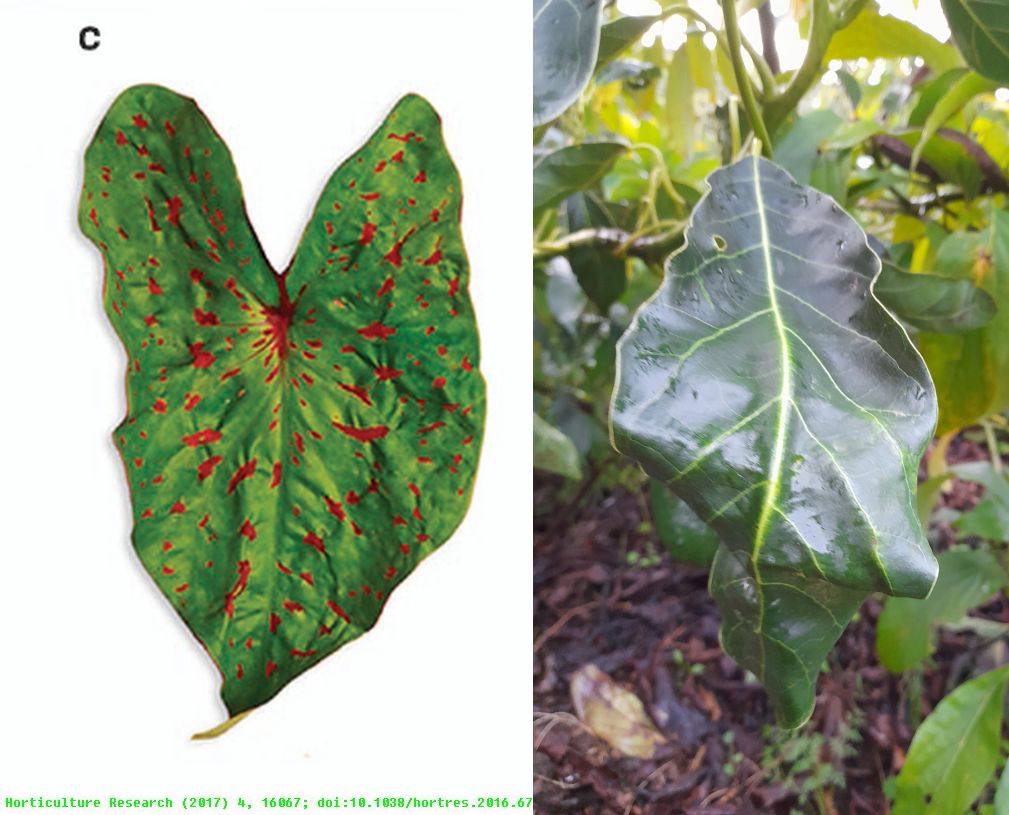
Rugose vs bullate - which is correct?
In general, plants whose leaves are bubbled, blistered or puckered -
as this avocado seedlings leaves are - are described as being
'bullate', from the latin word bullatus, inflated
or bubbled. Botanically, 'bullate' specifies leaves that are
bubbled, blistered or puckered. But the leaf of the primula,
for example, is described by one botanical source as 'rugose', and
by another source as 'bullate'. Which is correct? Botanical
descriptor words explaining the meaning of both 'bullate'
and 'rugose' commonly include the descriptor 'puckered'. Different
understandings of the meaning of the word 'puckered' may be the key
to explaining the apparent contradiction.
According
to the Missouri Botanical Garden 'Grammatical Dictionary of
Botanical Latin', in America the word 'puckered' is not generally
understood as meaning bubbled or blistered (although there are exceptions).
In American english puckered means: 'wrinkled, furrowed, drawn
together so as to crimp, contracted into folds or corrugations'. In
the rest of the english-speaking world, 'puckered' means bubbled,
drawn together into small folds, creased. The regularly puckered
fabric called seersucker
is an example of the concept. So a leaf described as 'puckered'
would usually mean something like creased or wrinkled to an
American, but to the majority of the world's english speakers it
would include 'bubbled' as well as corrugated. An American might
describe a bubbled leaf as 'rugulose' - which means 'finely' rugose.
It still doesn't explicitly capture the 'blister/bubble' concept.
In general, both bullate and rugose leaf forms are caused by a
mismatch between the growth rate of the leaf lamina and the veins.
In bullate leaves, the growth of the lamina is a little faster than
the veins, and the upper leaf surface is forced to inflate slightly
because it is trapped between the veins, thus causing a 'blistered'
or 'bubbled' leaf surface. As the venation pattern is regular, the
series of inter-vein inflations are also regular. If the entire leaf
is bubbled, then the term 'bullate', not 'rugose' is fully
appropriate in my (unschooled) opinion. Botanist might disagree.
In rugose leaves, the entire leaf may be unevenly (sometimes quite
exaggeratedly) distorted with various degrees of waves, wrinkles,
corrugations, and areas of pinching. These features might affect the
whole leaf, of just some sectors. Good examples are the
rugose-leaved ornamental caladium varieties. It seems to me that
vein-constrained, evenly and finely rugose leaves (sometimes called
'rugulose'), as in the leaves of Rosa rugosa are more
accurately described as bullate.
Bullate leaf surface mutation
This avocado seedling is an example of a mutation causing a bullate
leaf form. A gene causing the bullate mutation has been investigated
in soyabean (Bernard et al 1975).
"Several years ago at Urbana, plants with abnormal
leaves were noticed among segregates of crosses involving T217 (a
Korean introduction) and ' Clark'.
The leaf was quite rugose, much like one infected with mosaic
virus, but with characteristic circular bumps or a blister-like
upper surface. The term "bullate", used in plant taxonomy to
denote having a blistered or puckered surface, seems to be
appropriate for this trait.
Results obtained at Urbana gave evidence that bullate leaf was
controlled by two genes with both recessive alleles (here
designated lb1 and lb2) necessary for its
expression."
Bernard and Rode, USDA, 1975
Bernard et al (1975) found that the heterozygote plants showed a
slight bullate expression, sufficient to identify plants carrying
the bullate gene with a high degree of accuracy. This suggests a
dose-dependent expression, perhaps of a plant hormone
or of a transcription
factor. If a single recessive gene controlled the bullate leaf
form in avocado, then one in four selfed seedlings would be expected
to have bullate leaves. Unfortunately, it is very hard to control
pollination in avocado, so it is not realistic to attempt it here
(given time and energy constraints). The parent tree is a chance
seedling, and there is no trace of bullate form in its leaves. As
the fruit are black and pyriform, the parent is very likely to be
either Hass or Maluma. I have only grown a relatively few Hass
seedlings and haven't observed this mutation. It is not impossible
that this is a new dominant mutation. The question will likely
remain moot.
Leaf of the parent plant
(magnified).
Seedling with bullate upper leaf surface
Bernard, R. L.; Cremeens, C. R.; Rode, M.
W.; and Wax, L. M. 1975. 'Research Notes: U.S. Regional Soybean
Laboratory and University of Illinois, Urbana-Champaign'
Soybean Genetics Newsletter: Vol. 2, Article 13.
Available at: http://lib.dr.iastate.edu/soybeangenetics/vol2/iss1/13
Zhe Cao , Shunzhao Sui, Qian Yang and Zhanao Deng. 2016. Inheritance
of Rugose Leaf in Caladium and Genetic Relationships with Leaf
Shape, Main Vein Color, and Leaf Spotting
J. AMER. SOC. HORT. SCI. 141(5):527–534. 2016. doi:
10.21273/JASHS03854-16
Zhe Cao, Shunzhao Sui, Qian Yang, Zhanao Deng,
2017. A single gene controls leaf background color in caladium
(Araceae) and is tightly linked to genes for leaf main vein color,
spotting and rugosity,
Horticulture Research, Volume 4, 2017, 16067, https://doi.org/10.1038/hortres.2016.67
